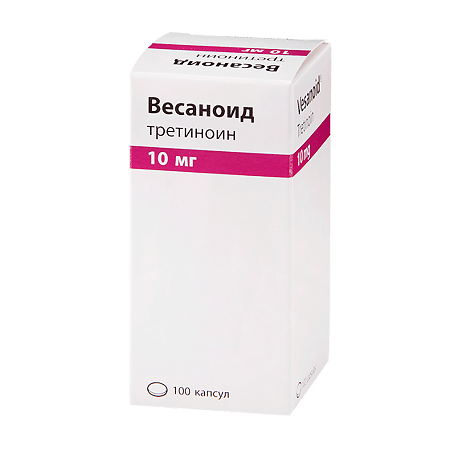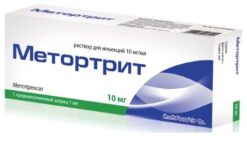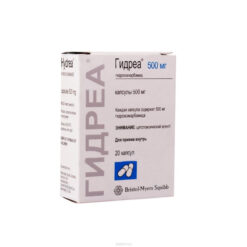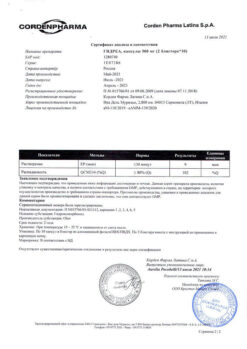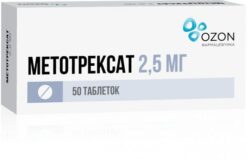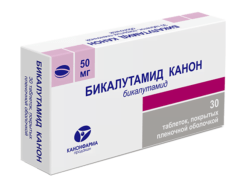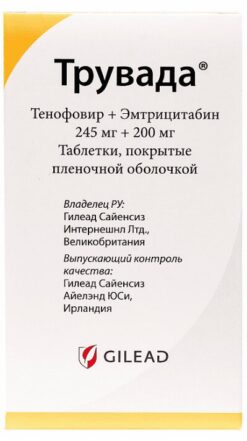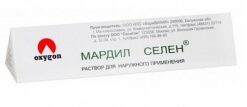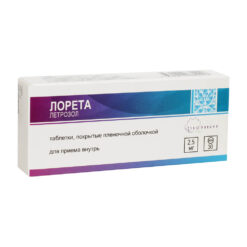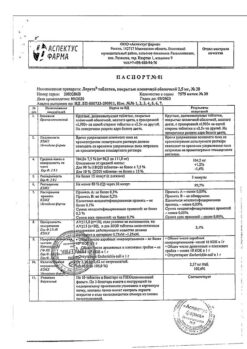No products in the cart.
Description
Antitumor drug. Systemic retinoid, inducer of cell differentiation. Tretinoin (fully trans-retinoic acid) is a natural metabolite of retinol belonging to the class of retinoids, which includes natural and synthetic analogues. In vitro studies have shown that trans-retinoic acid induces differentiation and suppresses proliferation of transformed hematopoietic cells, including in human myeloleukemia.
The mechanism of action in acute promyelocytic leukemia may be to alter binding of trans-retinoic acid to retinoic acid nuclear receptors, and the α-receptor of retinoic acid is also altered due to fusion with PML protein.
Pharmacokinetics
Absorption
Tretinoin (fully trans-retinoic acid) is an endogenous metabolite of vitamin A normally present in plasma. It is well absorbed after oral administration. Cmax in plasma is reached after 3 hours. Absorption varies greatly from patient to patient as well as in the same patient.
Distribution
The degree of binding to plasma proteins is high. After reaching a peak, the plasma concentration decreases. After single use of the drug in dose of 40 mg, plasma concentration returns to endogenous level in 7-12 hours. There is no cumulation of the drug in multiple doses; the drug is not retained in the tissues.
Metabolism
Tretinoin (fully trans-retinoic acid) isomerizes into 13-cis-retinoic acid and is oxidized to 4-oxymetabolites.
On repeated administration, plasma concentrations of the drug may decrease significantly, possibly due to induction of the cytochrome P450 enzyme system, which increases clearance and decreases bioavailability of the drug after oral administration.
The main route of elimination (60%) is excretion by the kidneys as metabolites formed by oxidation and glucuronidation. They have a longer T1/2 than trans-retinoic acid and can cumulate in small amounts. The average T1/2 is 0.7 h.
Pharmacokinetics in special cases
Particular pharmacokinetics and the need for dose adjustment in patients with impaired renal or hepatic function have not been studied.
Indications
Indications
Induction of remission in acute promyelocytic leukemia (APML; FAB classification – AML-M3).
Pharmacological effect
Pharmacological effect
Antitumor drug. Systemic retinoid, inducer of cell differentiation. Tretinoin (all-trans retinoic acid) is a natural metabolite of retinol, belonging to the retinoid class, which includes natural and synthetic analogues. In vitro studies have shown that trans-retinoic acid induces differentiation and suppresses the proliferation of transformed hematopoietic cells, incl. for myeloid leukemia in humans.
The mechanism of action in acute promyelocytic leukemia may involve altered binding of trans-retinoic acid to nuclear retinoic acid receptors, with the α-retinoic acid receptor also altered due to fusion with the PML protein.
Pharmacokinetics
Suction
Tretinoin (all-trans retinoic acid) is an endogenous metabolite of vitamin A, normally present in plasma. After oral administration it is well absorbed. Cmax in blood plasma is reached after 3 hours. Absorption varies greatly both in different patients and in the same patient.
Distribution
The degree of binding to plasma proteins is high. After reaching the peak, plasma concentration decreases. After a single dose of the drug in a dose of 40 mg, the plasma concentration returns to the endogenous level after 7-12 hours. With repeated doses, the drug does not cumulate, and the drug does not linger in the tissues.
Metabolism
Tretinoin (all-trans retinoic acid) isomerizes to 13-cis-retinoic acid and is oxidized to 4-hydroxy metabolites.
With repeated dosing, the plasma concentration of the drug may decrease significantly, possibly due to the induction of the cytochrome P450 enzyme system, which increases clearance and reduces the bioavailability of the drug after oral administration.
The main route of elimination (60%) is excretion by the kidneys in the form of metabolites formed during oxidation and glucuronidation. They have a longer T1/2 than trans-retinoic acid and can accumulate in small quantities. Average T1/2 is 0.7 hours.
Pharmacokinetics in special cases
Features of pharmacokinetics and the need for dose adjustment in patients with impaired renal or liver function have not been studied.
Special instructions
Special instructions
In patients with hyperleukocytosis that occurs during tretinoin monotherapy, prevention of retinoic acid syndrome involves the addition of full-dose chemotherapy (anthracyclines) while monitoring the level of leukocytes. The following treatment regimen is currently recommended:
immediate initiation of treatment if at the time of diagnosis or at any time during combination therapy with Vesanoid and chemotherapy, the number of leukocytes exceeds 5000/μl;
connection of full-dose chemotherapy to Vesanoid treatment in patients with a leukocyte count <5000/μl at the time of diagnosis, if leukocytosis increases to ≥6000/μl - on days 1-6 of treatment, ≥10,000/μl - on days 7-10 of treatment, ≥15,000/μl - on days 11-28 of treatment.
if the earliest signs of retinoic acid syndrome occur, it is necessary to begin a course of treatment with dexamethasone (10 mg every 12 hours for a maximum of 3 days or until the syndrome resolves);
in case of moderate and severe retinoic acid syndrome, it is necessary to consider the issue of temporary interruption of Vesanoid therapy.
Since there is a risk of thrombosis in the first month of therapy, caution must be exercised when treating patients with a combination of Vesanoid and antifibrinolytic drugs such as tranexamic acid, aminocaproic acid or aprotinin.
Vesanoid should be prescribed only to patients with acute promyelocytic leukemia under the close supervision of a hematologist or oncologist.
During treatment of patients with acute promyelocytic leukemia with tretinoin, supportive measures, such as bleeding prevention and anti-infective therapy, should be carried out. Frequent monitoring of blood counts, coagulation parameters, liver function, and triglyceride and cholesterol concentrations is necessary.
Impact on the ability to drive vehicles and other mechanisms that require increased concentration
When treated with Vesanoid, the ability to drive vehicles and operate machinery may be impaired, especially if patients experience dizziness or severe headaches.
Active ingredient
Active ingredient
Tretinoin
Composition
Composition
1 capsule contains:
Active substances:
tretinoin (all-trans retinoic acid) 10 mg.
Excipients:
yellow beeswax,
soybean oil,
hydrogenated soybean oil,
Soybean oil is partially hydrogenated.
Composition of the capsule shell:
glycerol 85%, gelatin, Karion 83 (hydrolyzed potato starch, mannitol, sorbitol), titanium dioxide (E171), yellow iron oxide dye (E172), red iron oxide dye (E172).
Contraindications
Contraindications
Hypersensitivity to the drug;
pregnancy;
lactation period (breastfeeding);
simultaneous intake of tetracyclines, mini-pills with progesterone and vitamin A.
Side Effects
Side Effects
When treated with the drug in recommended doses, symptoms of hypervitaminosis A were often observed, which occur with the use of all other retinoids.
Dermatological reactions: dry skin, erythema, rash, itching, increased sweating, alopecia, cheilitis, dry mucous membranes of the mouth, nose, conjunctiva and other mucous membranes, with or without signs of inflammation; rarely – formation of ulcers on the mucous membrane of the genital organs, Sweet’s syndrome, erythema nodosum.
From the central nervous system and peripheral nervous system: headache, intracranial hypertension (mainly in children), fever, chills, dizziness, confusion, anxiety, agitation, depression, paresthesia, insomnia, weakness.
From the senses: visual and hearing impairment.
From the musculoskeletal system: bone pain, chest pain; rarely – myositis.
From the digestive system: nausea, vomiting, abdominal pain, diarrhea, constipation, loss of appetite, pancreatitis, increased transaminase activity (ALT, AST).
Metabolism: increased concentrations of triglycerides, cholesterol, creatinine in the blood serum; in some cases – hypercalcemia.
From the respiratory system: pleural effusion, shortness of breath, respiratory failure, bronchospasm.
From the cardiovascular system: rhythm disturbances, hot flashes, swelling; in some cases – thrombosis.
From the hematopoietic system: rarely – thrombocytosis, severe basophilia with or without clinically manifested hyperhistamineemia, mainly in patients with a rare variant of acute promyelocytic leukemia with basophilic differentiation.
The decision to interrupt or continue therapy should be based on an assessment of the balance between the benefits of treatment and the severity of side effects.
Retinoic acid syndrome in acute promyelocytic leukemia
In clinical studies, hyperleukocytosis was often observed (75% of patients). In many patients with acute promyelocytic leukemia (up to 25%), during treatment with tretinoin, retinoic acid syndrome (IRA) occurs, which is characterized by fever, shortness of breath, acute respiratory distress syndrome, the occurrence of pulmonary infiltrates, arterial hypotension, pleural and pericardial effusion, edema, weight gain, hepatic, renal and multiple organ failure. IBS is often accompanied by hyperleukocytosis. Without treatment, this syndrome can be fatal.
Information on the use of tretinoin in children is limited. There are reports of increased toxicity in children receiving tretinoin, particularly intracranial hypertension.
Interaction
Interaction
Since tretinoin is metabolized by isoenzymes of the cytochrome P450 system, there is a possibility of altering the pharmacokinetics of concomitantly taken drugs that are inducers or inhibitors of this enzyme system. Drugs that stimulate the activity of isoenzymes of the cytochrome P450 system include rifampicin, corticosteroids, phenobarbital and pentobarbital. Drugs that inhibit the activity of cytochrome P450 isoenzymes include ketoconazole, cimetidine, erythromycin, verapamil, diltiazem and cyclosporine. There is no data that would indicate a change in the effectiveness or toxicity of these drugs when used simultaneously with Vesanoid.
There is no information on a possible pharmacokinetic interaction between tretinoin and daunomycin and cytosine arabinoside.
In patients simultaneously receiving Vesanoid and antifibrinolytic drugs (tranexamic acid, aminocaproic acid and aprotinin), rare cases of thrombotic complications with fatal outcome have been described. Therefore, if it is necessary to prescribe this combination, caution must be exercised.
Vesanoid reduces the contraceptive effectiveness of small doses of progestogens (“mini-pills”). Systemic retinoid therapy may lead to intracranial hypertension.
Since tetracycline drugs can also increase intracranial pressure, they should not be prescribed simultaneously with Vesanoid.
Like other retinoids, Vesanoid should not be used in combination with vitamin A due to increased symptoms of hypervitaminosis A.
Overdose
Overdose
Symptoms: To date, cases of acute overdose have not been described. Apparently, an accidental overdose of tretinoin will manifest itself with reversible symptoms characteristic of hypervitaminosis A.
The dose recommended for patients with acute promyelocytic leukemia is 1/4 of the maximum tolerated dose in patients with solid tumors and is less than the maximum tolerated dose for children.
Treatment: There is no specific treatment for overdose, but it is important that the patient is admitted to a hematology department.
Storage conditions
Storage conditions
Vials should be stored tightly closed, in a place protected from light, at a temperature not exceeding 30°C. Blisters should be stored in a place protected from light and moisture, at a temperature not exceeding 25°C.
The drug should be stored out of the reach of children.
Shelf life
Shelf life
3 years
Manufacturer
Manufacturer
Catalent Germani Schorndorf GmbH, Germany
Additional information
| Shelf life | 3 years |
|---|---|
| Conditions of storage | Vials should be kept tightly closed in the light-protected place at a temperature not exceeding 30°C. Blisters should be stored in a place protected from light and moisture at a temperature not exceeding 25°C. The drug should be kept out of reach of children. |
| Manufacturer | Catalent Germani Schorndorf GmbH, Germany |
| Medication form | capsules |
| Brand | Catalent Germani Schorndorf GmbH |
Related products
Buy Vesanoid, 10 mg capsules 100 pcs with delivery to USA, UK, Europe and over 120 other countries.

